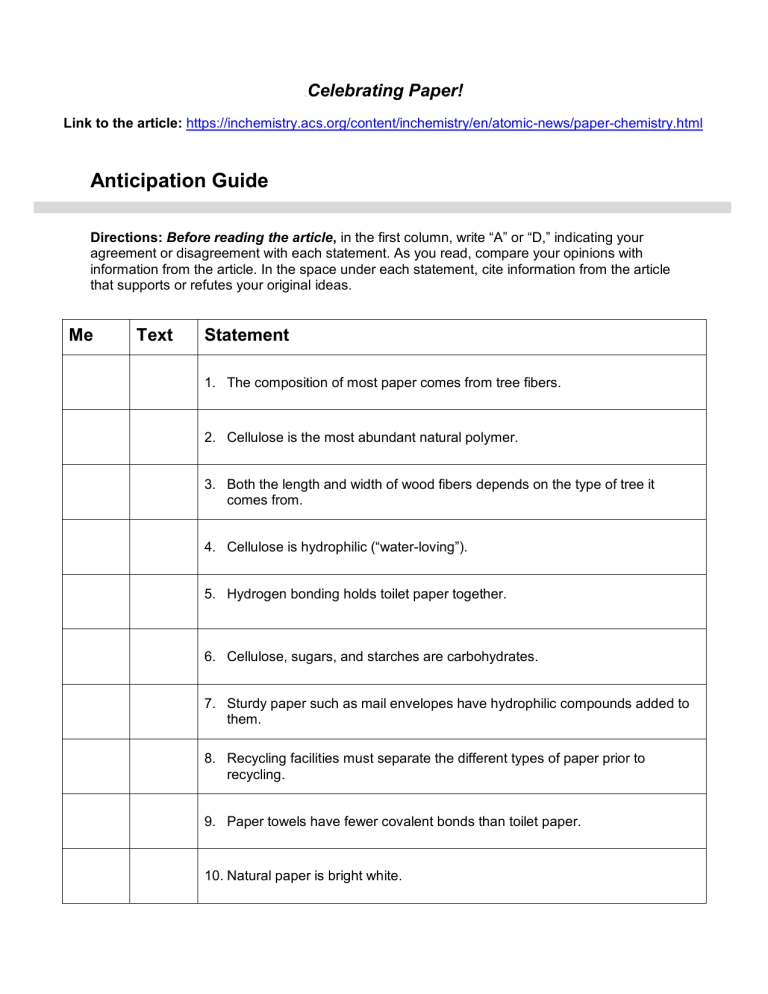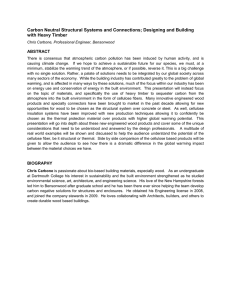
Link Celebrating Paper! Link to the article: https://inchemistry.acs.org/content/inchemistry/en/atomic-news/paper-chemistry.html Anticipation Guide Directions: Before reading the article, in the first column, write “A” or “D,” indicating your agreement or disagreement with each statement. As you read, compare your opinions with information from the article. In the space under each statement, cite information from the article that supports or refutes your original ideas. Me Text Statement 1. The composition of most paper comes from tree fibers. 2. Cellulose is the most abundant natural polymer. 3. Both the length and width of wood fibers depends on the type of tree it comes from. 4. Cellulose is hydrophilic (“water-loving”). 5. Hydrogen bonding holds toilet paper together. 6. Cellulose, sugars, and starches are carbohydrates. 7. Sturdy paper such as mail envelopes have hydrophilic compounds added to them. 8. Recycling facilities must separate the different types of paper prior to recycling. 9. Paper towels have fewer covalent bonds than toilet paper. 10. Natural paper is bright white. “Celebrating Paper!” ChemMatters, April/May 2019 Graphic Organizer Name: ______________________________ Directions: As you read, complete the graphic organizer below to compare different ingredients in paper. The last row refers to a hydrapulper, which is explained in the article. What is it? Structure Properties Interesting fact Cellulose Wood fibers Microfibrils Sizing agents How does it work? Hydrapulper Summary: In the space below, or on the back of this paper, write a short sentence (20 words or less) summarizing the article. 2 “Celebrating Paper!” ChemMatters, April/May 2019 Student Reading Comprehension Questions Directions: Use the article to answer the questions below. 1. In the table below, list three properties and a use for each that make paper useful for humans. Property Use clean and bright write notes on tough form shipping boxes soft and absorbent wipe noses 2. What are three characteristics of tree fibers that provide paper’s versatility? strong, flexible, and can bond to each other 3. Complete the table below regarding types of wood fibers. Type of wood fiber Longer fibers Shorter fibers Source evergreens in softwoods Length of fiber 3–5 mm long deciduous trees 1.2 mm Use to reinforce paper so that it can withstand being pulled apart or torn fill in gaps and make paper smooth 4. What force binds the long polymeric chains of cellulose to each other, forming rigid crystalline regions? long polymeric chains of cellulose 5. What is the composition of tree cell walls? multiple layers of microfibrils, which are made of cellulose: lumen, inner layer, middle layer, outer layer, primary wall 6. (a) Define hydrophilic, and (b) explain what effect this property has on cellulose. a) it's when water is attracted and can be absorbed between the microfibrils b) makes the fiber wall softer and even more flexible 3 “Celebrating Paper!” ChemMatters, April/May 2019 Student Reading Comprehension Questions, cont. 7. Why do some paper products, like toilet paper, come apart easily in water? because hydrogen bonding between cellulose chains provides all the strength that’s required for the final product. After use, these products should come apart easily, and because cellulose is hydrophilic, water can do the trick. It gets between the cellulose chains and causes the hydrogen bonds between cellulose molecules to break as new hydrogen bonds form between the cellulose and water. 8. How does a hydrapulper work to help recycle paperboard products? The hydrapulper vigorously mixes the paper (e.g., newspaper, corrugated containers) with water, and the fibers easily separate from each other, so they can be cleaned and reused. 9. (a) What are sizing agents used on paper, and (b) how do they work? a) organic compounds that are hydrophilic on one end and hydrophobic on the other. b) When they are added to the wood fibers, the hydrophilic ends covalently bond with cellulose during the drying process. The hydrophobic ends face outward toward the surface of the paper and help slow the absorption of water 10. What is done to paper towels to make them (a) strong, and (b) absorbent? manufacturers add chemicals called polymeric cross-linkers. These agents form covalent bonds between the cellulosic fibers, so that water can enter the structure without separating the fibers from each other. However, the amount of bonding in paper towels is limited. This keeps the density low, so lots of internal spaces are available for liquids to flow into 11. What substance is added to printer paper to make it appear brighter or whiter? calcium carbonate (CaCO3) particles Critical-Thinking Questions Write your answers on another piece of paper if needed. 1. Cellulose is a polysaccharide found in plants, while glycogen is a polysaccharide found primarily in animals. Research and then prepare a table comparing the composition and structure of cellulose and glycogen, including their monomers, bonding links, strengths, solubilities, sources, and uses. 2. The article mentions, but it does not completely describe, holocellulose, cellulose, and hemicellulose. Research and explain the composition and relationships among these three components. 4



